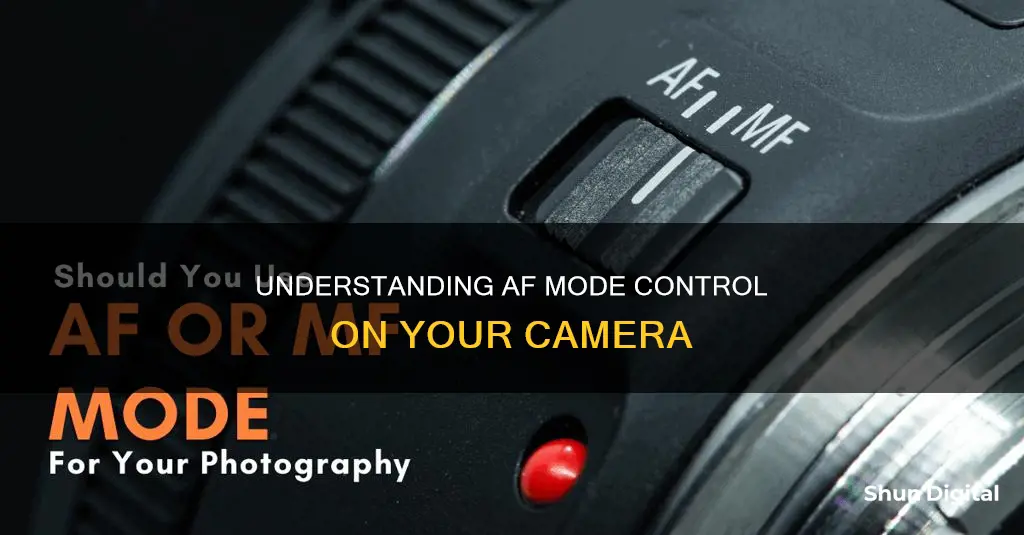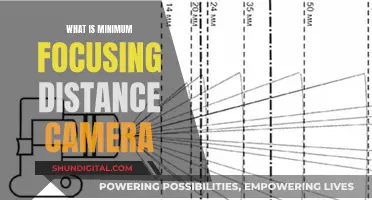
Autofocus (AF) is a feature on most modern digital cameras that allows the camera to automatically focus on a subject. The AF mode can be controlled by the photographer, who can select from a range of options depending on the camera model. The two main AF methods are AF-S (Single-shot AF) and AF-C (Continuous AF). AF-S locks the focus on a stationary subject once the autofocus has been achieved, whereas AF-C is more suitable for moving subjects as it continuously adjusts the focus. Some cameras also offer a hybrid mode, AF-A, which switches between AF-S and AF-C depending on whether the subject is stationary or moving.
| Characteristics | Values |
|---|---|
| Number of AF points | 11, 51, 5940 |
| Type of AF points | Vertical, horizontal, cross-type |
| AF mode | AF-S, AF-C, AF-A, MF, AI Servo AF, One-Shot AF |
| AF-Area mode | Single-Point, Dynamic, 3D-Tracking, Auto-Area, Group-Area, Face-Priority, Wide-Area, Normal-Area, Subject-Tracking |
What You'll Learn

AF-S mode locks focus on a non-moving object
AF-S mode, also known as AF Single, Single Area AF, or Single-Servo AF, is a camera setting that locks the focus on a non-moving object. This mode is ideal for photographing stationary subjects such as flowers, portraits, landscapes, or architecture.
When using AF-S mode, the camera focuses on the subject when the shutter button is pressed halfway down and remains locked on that focus until the picture is taken. This ensures that the subject of interest remains sharply focused, even if other objects move within the frame.
To use AF-S mode, you must first set your camera lens to autofocus (AF). Then, press the “AF Mode” or “Focus Mode” button, or flip the switch to cycle through the available focus modes until you reach AF-S. On Nikon cameras, this may be labelled as AF-S, while on Canon cameras, it is called One-Shot AF.
Once AF-S mode is selected, you can compose your shot and press the shutter button fully to capture the photograph. The focus will remain locked on the non-moving object, allowing you to capture a sharp and clear image.
AF-S is a useful mode for photographers who want to ensure their subject is in focus and do not need to track moving objects. It is a straightforward mode that is well-suited for still life, portrait, and landscape photography, where the subject remains stationary.
Camera Battery Leak: What You Need to Know
You may want to see also

AF-C mode is for moving objects
When shooting moving objects, the AF-C (AF continuous) mode is your best friend. This mode is designed to keep the focus on your subject even as it moves—for example, a dog running towards you. The camera will keep refocusing as long as you keep the shutter button pressed halfway down. This is in contrast to the AF-S (AF single) mode, which is meant for stationary subjects like flowers or portraits.
AF-C is also known as Continuous Servo AF and is ideal for capturing moving subjects. The camera will continuously adjust its focus as long as you hold down the shutter button halfway, allowing you to track the subject's movement. This mode is available on various camera brands, including Nikon, Canon, Sony, Pentax, and Panasonic Lumix cameras, although the specific names may vary slightly. For instance, Canon calls it AI Servo AF, while Sony uses the term Continuous AF.
When using the AF-C mode, it's important to keep the shutter button pressed halfway to maintain focus on the moving object. This can drain your battery more quickly than other modes, as the camera is constantly refocusing. Additionally, the AF-C mode is most effective when combined with a zone or multi-point focus area, allowing the camera to track the subject within a specific area of the frame.
While AF-C is excellent for moving objects, it may not be the best choice for all situations. In low-light conditions or when dealing with uniformly coloured scenes, autofocus systems can struggle. In such cases, switching to manual focus (MF) or single autofocus (AF-S) mode might be more suitable.
Action Camera Batteries: How Long Do They Last?
You may want to see also

AF-A mode switches between AF-S and AF-C
AF-A mode is an autofocus mode that automatically switches between AF-S and AF-C depending on whether the subject is stationary or moving.
AF-A is the default camera focus mode on many cameras, including Nikon and Canon models. When a camera is set to AF-A mode, it detects whether the subject is stationary or moving and adjusts the autofocus setting accordingly. If the camera detects that the subject is stationary, it will automatically use AF-S focus mode. If it detects that the subject is moving, it will automatically switch to AF-C focus mode.
AF-S (AF single) is suitable for photographing stationary subjects as it locks the focus onto the subject. AF-C (AF continuous) is better for capturing moving subjects as the camera will continuously adjust the focus to track the subject's movement.
While AF-A is a useful default setting, photographers often prefer to manually select the focus mode themselves as they do not always trust the camera to pick the correct setting.
Mastering Adjustment Brush Undo in Camera Raw
You may want to see also

Manual focus is useful in low-light conditions
Manual focus is also beneficial when photographing the night sky, as the autofocus will likely miss the focus. It is also more reliable than autofocus when shooting in low-light conditions and in genres like macro, architecture, and stills.
To achieve manual focus in low-light conditions, you can use the following steps:
- Turn on the live view and zoom in on the scene.
- Navigate to your subject or the part of the scene you want in focus with your AF point.
- Engage live view and zoom in on the screen to find a bright point of light, such as a star or streetlight.
- Spin the focus ring to get a smaller, sharper point of light.
- Engage manual focus on the lens or camera body and adjust the focus ring until the subject is sharp.
- Disengage autofocus to avoid the lens hunting for focus and spoiling your efforts.
- Use a tripod to stabilise the camera, as low-light conditions may require a long shutter speed.
- Use a remote shutter release or an exposure delay mode to prevent camera shake.
In addition to the above technique, you can also use a powerful LED torch or flashlight to shine on your subject and manually focus using the live view zoom technique. This can be useful if you are struggling to see your subject in very dark conditions.
Shutter Mode Simplified: Easy Steps for Canon Cameras
You may want to see also

Autofocus can struggle with low-contrast scenes
Autofocus systems can struggle in low-light conditions or when faced with a low-contrast or uniformly coloured scene, such as a brown dog in a muddy field. In these situations, the autofocus system may focus back and forth, hunting for something to lock onto. If there is anything in front of the subject, such as a window or the bars of a cage, the camera will likely focus on that instead.
Low-contrast images, suffering from a lack of sharpness, are easily influenced by noise, which can cause local false peaks to be generated in contrast measurements. This makes it difficult for the camera's autofocus system to locate the focused peak.
Passive autofocus systems, which determine correct focus by performing passive analysis of the image entering the optical system, may not find focus when the contrast is low, especially on large single-coloured surfaces (like walls or the sky) or in low-light conditions. However, passive autofocusing can be achieved by phase detection or contrast measurement.
Phase detection autofocus (PD AF) is achieved by dividing the incoming light into pairs of images and comparing them. The two images are analysed for similar light intensity patterns, and the separation error is calculated to find whether the object is in front or back focus. This gives the direction and an estimate of the required amount of focus-ring movement.
Contrast-detection autofocus (CDAF) is achieved by measuring contrast within a sensor field through the lens. The intensity difference between adjacent pixels of the sensor naturally increases with correct image focus. The optical system can be adjusted until maximal contrast is detected. This method does not involve actual distance measurement. CDAF creates significant challenges when tracking moving subjects since a loss of contrast gives no indication of the direction of motion.
Canon's Dual Pixel CMOS AF system, introduced in the EOS 70D in 2013, uses every pixel on the imaging sensor for autofocusing, meaning the active AF area covers the entire image frame. This gives the camera a significant advantage for tracking a subject around the frame, as there are no gaps between the AF points.
Some cameras have an autofocus assist beam, which "activates" passive autofocus systems in low-light and low-contrast situations. The lamp projects visible or infrared light onto the subject, which the camera's autofocus system uses to achieve focus.
Unraveling Camera Battery Composition: What Powers Photography?
You may want to see also
Frequently asked questions
AF stands for Auto Focus. When you set your camera lens to AF, digital SLR cameras offer the photographer interchangeable modes.
AF-S stands for Auto Focus Single and is used for photographing stationary objects. AF-C stands for Auto Focus Continuous and is used for photographing moving objects.
AF-A stands for Auto Focus Automatic and switches between AF-S and AF-C depending on whether the subject is stationary or moving. MF stands for Manual Focus and allows the photographer to adjust the focus manually.
You should use AF mode when you want your camera to focus automatically. This is especially useful when you want to pay more attention to other aspects of your photography, such as composition and exposure.
This depends on your camera model. On some cameras, you can change the AF mode through the camera settings menu, while others have a dedicated button on the camera body.







